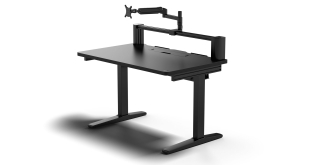Firstly, we are pleased to report that our Roccat Kone XTD mouse worked to its usual standard in the MSI X79A-GD45 Plus motherboard's UEFI BIOS. This is a positive point as we have experienced problems when using certain mice in the UEFI BIOS of other motherboards in the past.
We tested an NZXT Avatar S mouse with the interface but it did not work (the mouse's fault). Issues could be caused for users with a mouse that doesn't work inside the UEFI; MSI's interface relies on the mouse function more than many of its competitors' implementations.
The main page of MSI's UEFI BIOS displays a good amount of information relating to temperatures, frequencies, and boot device priorities. It also provides quick access to the interface's main sub-sections.
Connected SATA devices and the amount of physical memory installed are displayed on the system status page.
The hardware monitor page displays operating temperatures and allows fan speed parameters to be tweaked. We like MSI's method for controlling the CPU fan header; a user can select a desired CPU temperature and then set the minimum fan speed (all of the way down to 0%) that will be used while the target is being achieved.
Plenty of frequency, multiplier, and voltage parameters can be tweaked via the overclocking section. Unfortunately, the interface isn't the best we have seen – readouts are mixed in with parameters that can be changed. We would prefer the readouts to be placed in a separate column, adjacent to their relating parameter's input box.
Asus and ASRock use a style which separates the parameters and inputs and it combines to form a good-looking interface which is easy to use.
When conducting our overclocking tests, we noticed that MSI's motherboard does not update the frequency of memory dividers when the base clock is changed. For example, we increased the base clock to 125MHz, selected the 1600MHz memory option, and were given a 2000MHz memory speed (which was displayed beneath the memory frequency input box, NOT on the options list).
A plethora of DRAM Timings can be tweaked via a specific section.
Up to six overclocking profiles can be saved to the MSI X79A-GD45 Plus motherboard. Each profile can be given an individual name and the date of its build is also displayed. If six save points isn't enough, or if you want to share somebody else's settings, profiles can be imported and exported via a USB flash drive.
The X79A-GD45 Plus' main utilities are HDD backup, Live Update, and M-Flash. We used the M-Flash utility to upgrade the board's BIOS for overclocking testing. Unlike many of its competitors' implementations, M-Flash requires the BIOS file to be saved in the root folder of a USB flash drive.
Overall, the MSI X79A-GD45 Plus motherboard's UEFI BIOS is well-equipped and generally easy to use. The overclocking section is a little untidy, with input parameters mixed in with readouts, but it is by no means unusable and will become more straightforward with practise.
There are a few irritating factors, such as a memory frequency options box that doesn't update with a changed base clock and the M-Flash utility that only reads from a USB drive's root folder, but these are not major issues and are easy for MSI to fix.
 KitGuru KitGuru.net – Tech News | Hardware News | Hardware Reviews | IOS | Mobile | Gaming | Graphics Cards
KitGuru KitGuru.net – Tech News | Hardware News | Hardware Reviews | IOS | Mobile | Gaming | Graphics Cards














Weird